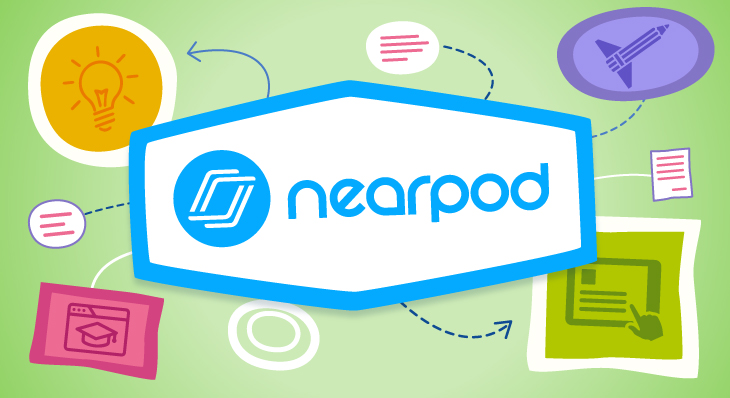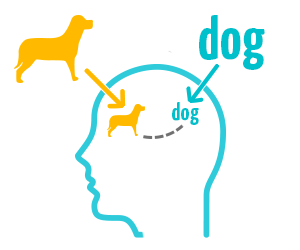This resource was made by Chloe, Jason, Megan, and myself.
Introduction to our Media Object; Nearpod.
For our Multimedia Design project, we have decided to compile a series of video tutorials intended to instruct learners, primarily classroom teachers, on how to use the educational resource Nearpod to present material to students. To elaborate, Nearpod is a digital platform where teachers can upload their previously made lessons (PowerPoints, GoogleSlides, PDFs, etc.) and edit them for further interaction (Nearpod, n.d.). Choosing a premade lesson off of Nearpod’s library, or creating one from scratch on Nearpod itself are also available options (Nearpod, n.d.). Specifically, teachers can add formative assessment check-ins to gauge student understanding by incorporating quizzes, open-ended questions, and audio responses (Nearpod, n.d.). Additionally, teachers can add media such as Virtual Reality simulations or integrate relevant websites and videos to increase student engagement (Nearpod, n.d.). When it comes to content delivery, Nearpod offers 3 means;
1. Live participation, ideal for in-person or video-conferencing learning, where teachers control the pace of the lesson and students participate on their own devices (Nearpod, n.d.).
2. Student-paced, ideal for at-home learning, where students progress at their own speed (Nearpod, n.d.).
3. Front of class, ideal for in-person learning, where teachers can project their lessons to facilitate collaborative discussions, and student devices are not needed (Nearpod, n.d.).
Rationale
With the uncertainty and inconsistency of in-person and at-home learning due to COVID-19 for teachers around the world this past year, we were inspired to focus our assignment 4 on Nearpod as it offers a comprehensive solution by allowing each uploaded lesson to be adaptable to the given circumstances (i.e. live participation or student-paced). As well, if a student was away for an extended period of time or needed extra support in terms of having a concrete copy of a lesson, Nearpod is a great course of action. We also liked how seamlessly formative assessment can be integrated into each Nearpod lesson – we recognize that oftentimes this can be a challenge for teachers, but, as made accessible through Nearpod, having check-ins actually a part of each lesson rather than an activity afterwards, that can digitally record student data, would make evaluation easier.
Overview
To educate learners about Nearpod, we have created 5 video tutorials, introducing the basic, necessary skills of creating a Nearpod account, navigating the Nearpod library to find and save a pre-made lesson, editing existing features within a saved Nearpod lesson, adding a video to a saved Nearpod lesson, understanding the difference between live participation and student-paced Nearpod lesson, and giving students access to a Nearpod lesson. We would ask all learners to follow along with our videos, stopping when needed, to take part in a more hands-on experience, and to walk away confident using Nearpod on their own.
Learning Outcomes
Each learning outcome below has a corresponding video tutorial that learners can follow along with to help them familiarize themselves with Nearpod and its basic features.
By the end of this topic, learner’s will be able to:
• Create a Nearpod teacher account
• Navigate the Nearpod library to find and save a pre-made lesson. Open lesson and show how a lesson can be edited (click in to show how a lesson can be changed
• Edit existing features within a saved Nearpod lesson.
• Add a video to a saved Nearpod lesson.
• Understand the difference between a student-paced and live Nearpod lesson.
• Give learners access to a Nearpod lesson.
• Create their own Nearpod lesson using multiple tools.
Evaluation
In the last tutorial video, learners will be instructed to create their own mini Nearpod presentation using the skills learned in the prior videos. We purposefully left a degree of flexibility in the hands-on activity so that they could play with and explore the tools they feel would benefit their slides the most. The finished slides would then be posted as a blog post or emailed to the educator for assessment. We would specifically be checking that a variety of Nearpod slides were included and that they were customized to the learner’s chosen theme. This would show us if they understand how to create and edit presentations using Nearpod.
Obstacles
There are two main obstacles that we found while putting this resource together. The first being that the text is not editable in the premade Nearpod slides. It was originally planned that we would create a tutorial editing elements within premade slides, but this proved to be tough without being able to edit the written portions of them. Second, there are so many features and options to explore within Nearpod that it was tricky to widdle it down to a few key points that strung together nicely for our tutorials.
Learning Theories
Our Multimedia Design project was made according to the model of experiential learning, whose goal is to engage learners in direct experience to increase their knowledge and skill development (Queen’s Experiential Learning Hub, n.d.). Specifically, we have created video tutorials highlighting the basic competencies needed to navigate Nearpod, which learners can use as a guide to explore the website with themselves. Thus, while completing our resource, learners will be gaining hands-on practice with Nearpod, which they can later apply to their future presentations. In cohesion with the experiential learning model, and as similarly described, we have based our assignment on-off of the educational theory of constructivism, which is founded on the belief that authentic learning takes place when students can actively take part in the process of meaning-making (Ertmer & Newby, 2013). The preceding implies that when a lesson is taught in a constructivist manner, students are given chances to explore, reflect, and evaluate new ways of thinking, as well as relate them to their prior knowledge (Ertmer & Newby, 2013). Thus, while we have provided video tutorials showing how to use Nearpod, they are merely a jumping-off point for learners; while accessing them learners are encouraged to progress at their own pace, stopping to extend their understanding by asking questions or take initiative by further investigating a particular topic of interest.
Multimedia Theories and Principles
In order to create optimal learning conditions for those utilizing our project, we have adhered to three of the information processing theories touched on in EDCI 337. To elaborate, with Dual Coding Theory stating that humans store sensory input in verbal and non-verbal subsystems, our video tutorials combine audio and visual input, so that learners can receive instruction in two formats (Cognitive Theory of Multimedia Learning, 2011). We also recognize the role of active processing in a learning experience, where learners must be actively engaged to make sense of the content being presented (Cognitive Theory of Multimedia Learning, 2011). So, as previously described, we have designed our resource so that individuals may experiment with Nearpod, rather than passively listening to us speak about it. Finally, in an effort to avoid overloading the working memory, which is described as finite in the Cognitive Load Theory, we have incorporated the following of Mayer’s Principles of Multimedia Learning to ensure that our work is as user-friendly to interact with as possible (Mayer & Fiorella, 2014).
In order to create optimal learning conditions for those utilizing our project, we have adhered to three of the information processing theories touched on in EDCI 337. To elaborate, with Dual Coding Theory stating that humans store sensory input in verbal and non-verbal subsystems, our video tutorials combine audio and visual input, so that learners can receive instruction in two formats (Cognitive Theory of Multimedia Learning, 2011). We also recognize the role of active processing in a learning experience, where learners must be actively engaged to make sense of the content being presented (Cognitive Theory of Multimedia Learning, 2011). So, as previously described, we have designed our resource so that individuals may experiment with Nearpod, rather than passively listening to us speak about it. Finally, in an effort to avoid overloading the working memory, which is described as finite in the Cognitive Load Theory, we have incorporated the following of Mayer’s Principles of Multimedia Learning to ensure that our work is as user-friendly to interact with as possible (Mayer & Fiorella, 2014).
1. Modality and multimedia principle – our video tutorials combine graphics and verbal narration (Mayer & Fiorella, 2014).
2. Segmenting principle – our video tutorials are presented in learner-paced segments rather than as a continuous unit (Mayer & Fiorella, 2014).
3. Personalization principle – our video tutorials employ a conversational style of narration rather than a formal one (Mayer & Fiorella, 2014).
4. Image principle – we have refrained from adding a speaker’s image to our video tutorials (Mayer & Fiorella, 2014).
References
Cognitive Theory of Multimedia Learning. (2011). In ETEC510: Design Wiki. http://etec.ctlt.ubc.ca/510wiki/Cognitive_Theory_of_Multimedia_Learning
Ertmer, P. A., & Newby, T. J. (2013). Behaviorism, cognitivism, constructivism: Comparing critical features from an instructional design perspective. Performance Improvement Quarterly, 26(2), 43-71.
Mayer, R., & Fiorella, L. (2014, August). Principles for Reducing Extraneous Processing in Multimedia Learning: Coherence, Signaling, Redundancy, Spatial Contiguity, and Temporal Contiguity Principles. In R. Mayer (Ed.), The Cambridge Handbook of Multimedia Learning (Cambridge Handbooks in Psychology, pp. 279-315). Cambridge: Cambridge University Press. doi:10.1017/CBO9781139547369.015
Nearpod. (n.d.) How Nearpod Works. https://nearpod.com/how-nearpod-works
Queen’s Experiential Learning Hub. (n.d.). https://www.queensu.ca/experientiallearninghub/about/what-experiential-learning

